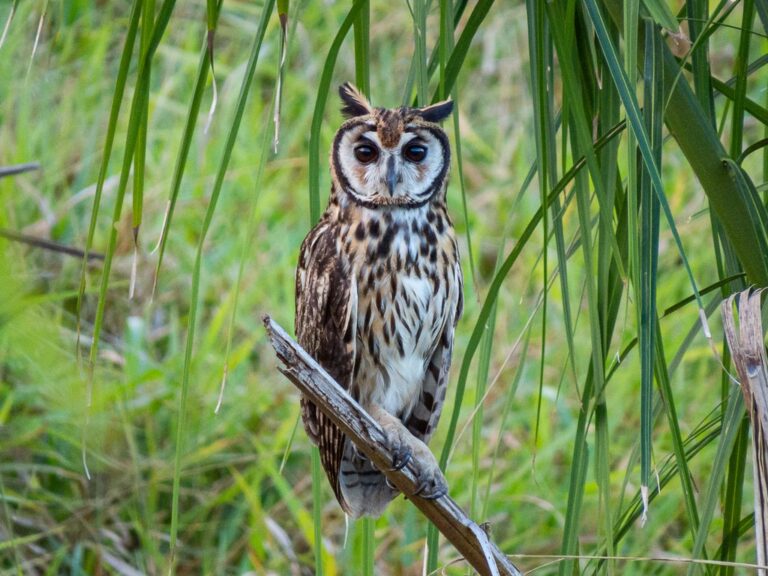Birdfinding.info ⇒ Uncommon and local across most of its large range—but increasing and expanding as it proves adaptable to human development. Fairly common from southeastern Brazil to eastern Argentina, including urban areas around São Paulo and Buenos Aires. Other cities where it is seen regularly include San José, Costa Rica, and Bogotá and Medellín, Colombia. Rare in Mexico, but fairly common around Flores, Guatemala, and in west-central Belize. The potentially distinct “Tumbes Owl” has been found on the western and northern outskirts of Guayaquil, Ecuador, and in the foothills above Chiclayo, Peru.
Striped Owl
Asio clamator
Neotropics from southern Mexico to Argentina.

Approximate distribution of the Striped Owl, including the potentially distinct “Tumbes Owl”. © BirdLife International 2021
Widely but patchily distributed in savannas and other semi-open habitats of the tropical lowlands and foothills from southern Veracruz south and east through Central America and northern South America—including intermontane Andean valleys of Colombia, Venezuela, Ecuador, and Peru—and south essentially throughout eastern South America to central Argentina (to northern Río Negro and southern Buenos Aires Province).
Historically either absent from extensively forested areas or limited to edge habitats, but it currently inhabits all parts of Amazonia wherever the forest has been at least partly cleared.
A small population is resident on Tobago. It has also occurred formerly or sporadically on Trinidad, where it was last recorded in 1941.
Highly localized on the Pacific slope of South America. In Colombia, records from the Chocó lowlands seem likely to be the result of dispersal from Panama or the Cauca Valley.
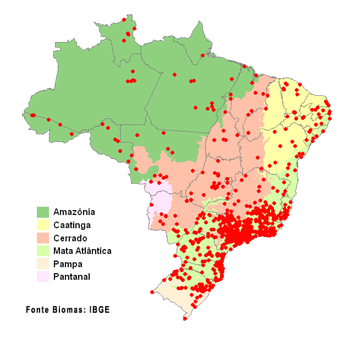
Brazilian records of the Striped Owl, by municipality. © WikiAves 2023
A distinctive population that appears certain to be a separate taxon, and possibly a separate species—tentatively known as the “Tumbes Owl” (A. c. ssp. nova)—occurs in the Pacific lowlands of Ecuador (north to Manabí) and Peru (south contiguously to La Libertad, but recorded south to Lima and Ica).
Identification
A distinctive medium-sized owl recognized by its conspicuous ear-tufts, black-rimmed facial disk, and boldly streaked underparts.
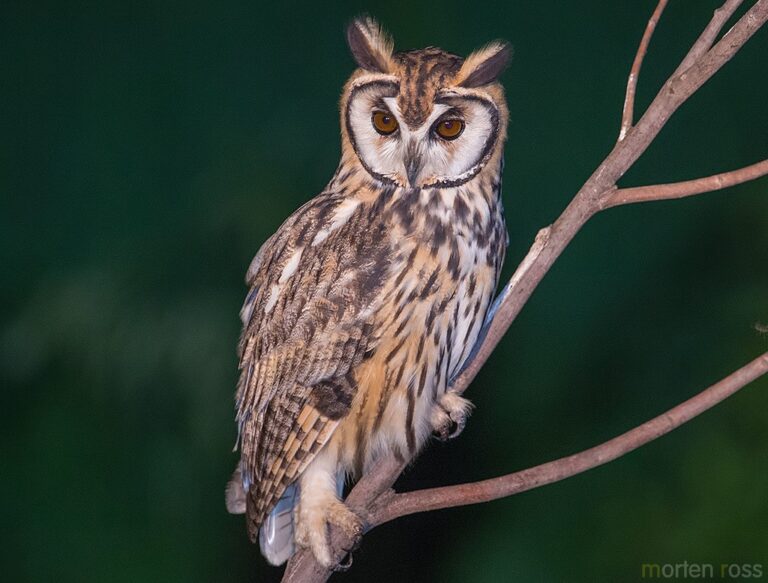
Striped Owl. (Miranda, Mato Grosso do Sul, Brazil; November 11, 2013.) © Morten Ross
Mostly nocturnal, but sometimes active around dusk, less often during daytime. Sometimes inhabits towns and agricultural areas, where it often perches on electrical wires and other infrastructure.
The prominent ear-tufts are wide and long, mostly black with buffy streaks.
The facial disk is usually white with varying amounts of buff or ochre around the eyes. Darker individuals typically show a contrasting whitish X between the eyes.
The large-looking eyes are warm-brown but often appear all-dark.
The upperparts are mottled and vermiculated in shades of brown, black, and buff.
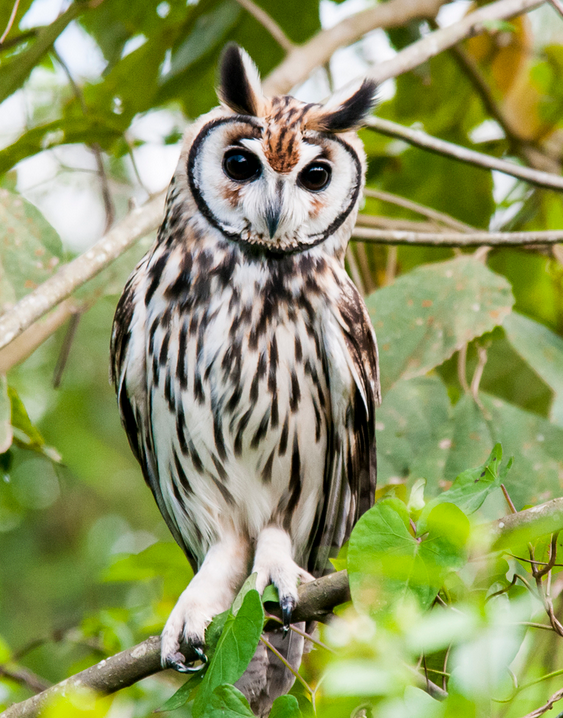
Striped Owl, a pale, boldly patterned individual. (Praia Grande, São Paulo, Brazil; October 19, 2013.) © Walter Mello
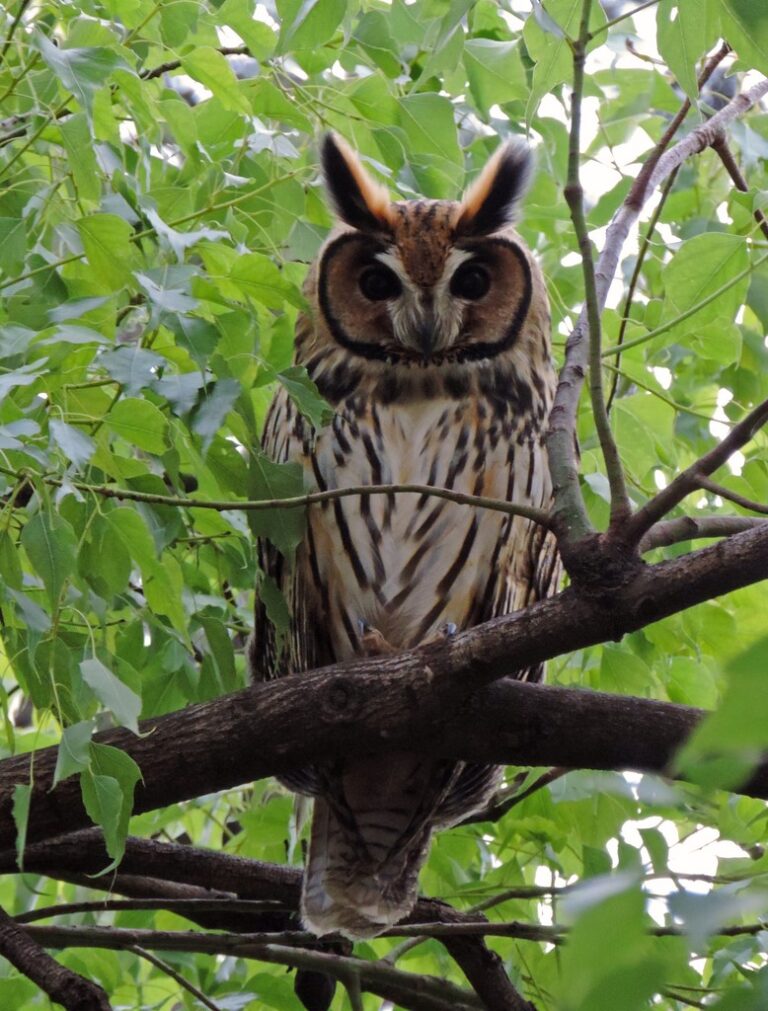
Striped Owl, a relatively dark-faced individual. (Bahía Blanca, Buenos Aires, Argentina; June 14, 2017.) © emi_bravo
The underparts are mostly pale with varying amounts of buff or ochre and strong black stripes or streaks throughout; densest on the chest.
Juveniles have bright orange-buff underparts and mottled upperparts, and show a boldly black-rimmed facial disk like the adult’s. The underparts are unmarked at first; bold striped feathers grow in within the first two months or so.
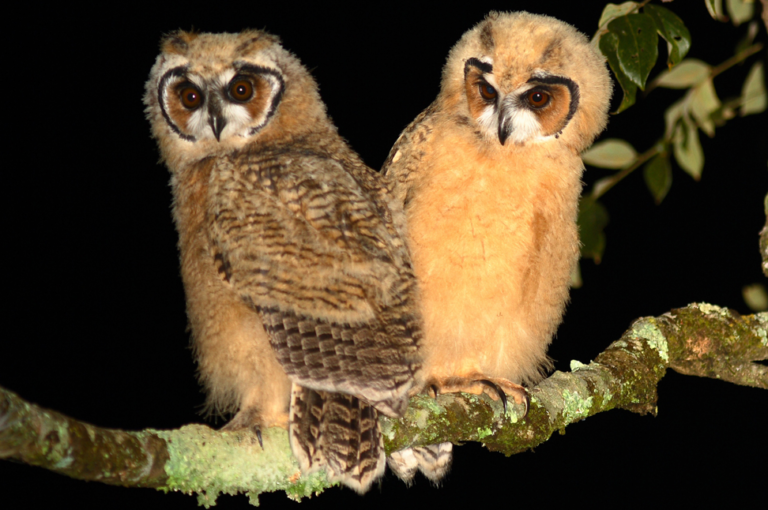
Striped Owl, juveniles. (Jacutinga, Minas Gerais, Brazil; May 27, 2007.) © Geiser Trivelato
In flight, the uppersides of the wings are heavily banded and show a large blackish wrist-patch on the outer primary coverts.
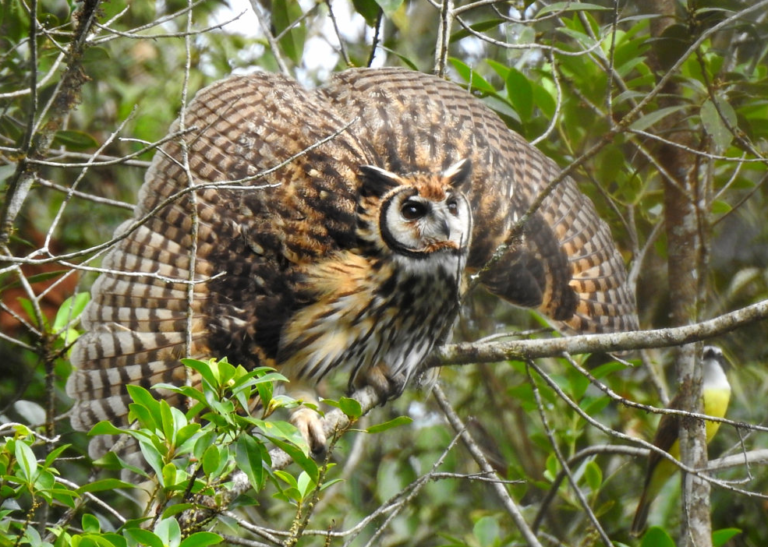
Striped Owl in threat display, showing the uppersides of its spread wings with blackish wrist patches on outer primary coverts—note the kiskadee-type flycatcher in the lower right foreground. (Divino de São Lourenço, Espirito Santo, Brazil; May 15, 2022.) © André Pellanda
The undersides of the wings are mostly pale with thin black bands on the flight feathers and a black crescent at the base of the primaries.

Striped Owl, ventral view in flight, showing the black crescent at the base of the primaries. (Resende, Rio de Janeiro, Brazil; August 15, 2019.) © Carlos Zikan
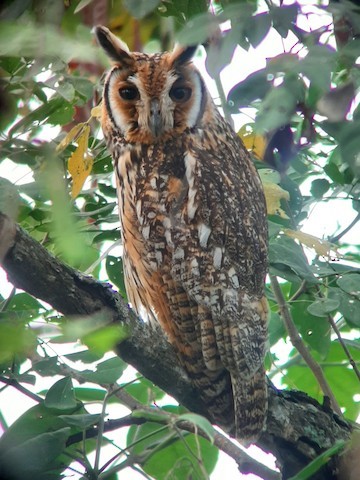
“Tumbes Owl”, A. c. ssp. nova, an especially rufous individual. (Refugio de La Tomatera, Portoviejo, Ecuador; June 16, 2022.) © Daniel Arias-Cruzatty
“Tumbes Owl”. The potentially distinct and as-yet undescribed “Tumbes Owl” (A. c. ssp. nova) resembles typical Striped Owls, but averages darker and rustier, and appears to differ consistently in certain aspects of its plumage pattern.
The area within its facial disk is bicolored, with an ochre or orange-brown vertical stripe that frames the eye and extends down to the chin, contrasting with a white vertical stripe on the outer half of the facial disk. (Some dark individuals from typical Striped Owl populations may show approximately the same coloration, but rarely if ever with comparably strong contrast.)
The upperparts of “Tumbes Owls” are darker and more boldly mottled than on most typical Striped Owls, and have rows of well-defined white spots on the wing-coverts.
The underparts are predominantly buffy or orange-brown and boldly streaked—this pattern is the same as on many typical Striped Owls, but the base coloration averages richer and darker.
In addition to differences in plumage, “Tumbes Owl” may differ vocally from typical Striped Owls (see below).

“Tumbes Owl”, A. c. ssp. nova. (Sendero Lomas del Bosque, Guayas, Ecuador; November 4, 2021.) © Jose Daniel Tomalá Rossi
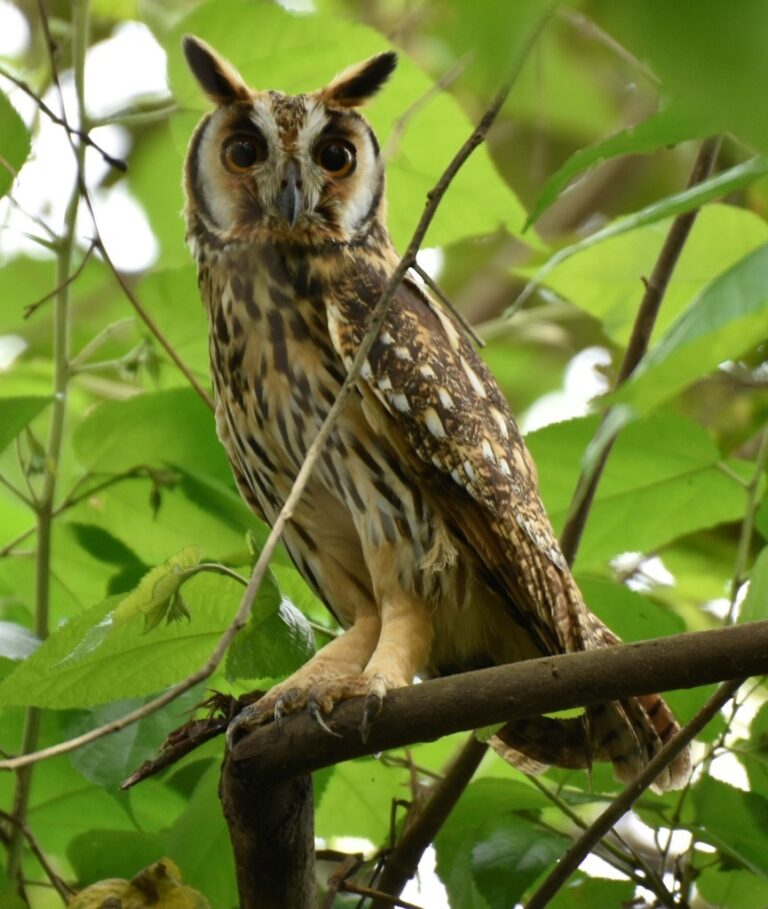
“Tumbes Owl”, A. c. ssp. nova. (Bolivar, Manabí, Ecuador; January 3, 2021.) © jorgebrito
Voice. Most commonly heard call is a thin, shrill whistle—possibly only females and immatures: The male’s territorial call is a muffled hoot:The male sometimes gives isolated barks:Both sexes sometimes give a rapid series of barks, sometimes duetting:And sometimes screeches:The “Tumbes Owl” of the Pacific slope of Ecuador and Peru is reported to be vocally distinct. Its recorded calls appear to be exclusively harsh barks and screeches:
Notes
Polytypic species consisting of three recognized subspecies and a fourth, potentially distinct subspecies, the “Tumbes Owl” (ssp. nova) of western Ecuador and Peru, which has not been formally described. The latter appears to have consistently redder plumage and a distinctive facial pattern, and may be vocally distinct from typical Striped Owls.
References
Ascanio, D., G.A. Rodriguez, and R. Restall. 2017. Birds of Venezuela. Christopher Helm, London.
BirdLife International. 2021. Asio clamator. The IUCN Red List of Threatened Species 2021: e.T22689522A167863611. https://dx.doi.org/10.2305/IUCN.UK.2021-3.RLTS.T22689522A167863611.en. (Accessed September 2, 2023.)
eBird. 2023. eBird: An online database of bird distribution and abundance. Cornell Lab of Ornithology, Ithaca, N.Y. http://www.ebird.org. (Accessed September 2, 2023.)
Erize, F., J.R. Rodriguez Mata, and M. Rumboll. 2006. Birds of South America: Non-Passerines: Rheas to Woodpeckers. Princeton University Press.
Fagan, J., and O. Komar. 2016. Peterson Field Guide to the Birds of Northern Central America. Houghton Mifflin Harcourt, New York.
ffrench, R. 2012. A Guide to the Birds of Trinidad & Tobago (Third Edition). Cornell University Press.
Garrigues, R., and R. Dean. 2014. The Birds of Costa Rica: A Field Guide (Second Edition). Cornell University Press.
Howell, S.N.G., and S. Webb. 1995. A Guide to the Birds of Mexico and Northern Central America. Oxford University Press.
iNaturalist. 2023. https://www.inaturalist.org/. (Accessed September 2, 2023.)
Kenefick, M., R. Restall, and F. Hayes. 2008. Field Guide to the Birds of Trinidad & Tobago. Yale University Press.
König, C., and F. Weick. 2008. Owls of the World (Second Edition). Yale University Press.
McMullan, M., and T. Donegan. 2014, Field Guide to the Birds of Colombia (Second Edition). Fundación Proaves de Colombia, Bogotá.
Mikkola, H. 2013. Owls of the World: A Photographic Guide (Second Edition). Firefly Books, London.
Owl Pages. 2023. Striped Owl ~ Asio clamator. https://www.owlpages.com/owls/species.php?s=3580. (Accessed September 2, 2023.)
Ridgely, R.S., and P.J. Greenfield. 2001. The Birds of Ecuador, Volume II: Field Guide. Cornell University Press.
Ridgely, R.S., and J.A. Gwynne. 1989. A Guide to the Birds of Panama (Second Edition). Princeton University Press.
Schulenberg, T.S., D.F. Stotz, D.F. Lane, J.P. O’Neill, and T.A. Parker. 2007. Birds of Peru. Princeton University Press.
Stiles, F.G., A.F. Skutch, and D. Gardner. 1989. A Guide to the Birds of Costa Rica. Cornell University Press.
van Perlo, B. 2009. A Field Guide to the Birds of Brazil. Oxford University Press.
Wikiaves. 2023. Coruja-orelhuda, https://www.wikiaves.com.br/wiki/coruja-orelhuda. (Accessed September 2, 2023.)
Xeno-Canto. 2023. Striped Owl – Asio clamator. https://xeno-canto.org/species/Asio-clamator. (Accessed September 2, 2023.)
